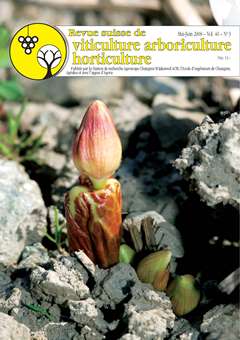
Issue 3 - May - June 2008
Abstract in open access
The Swiss Vitis Microsatellite Database (SVMD) contains the genetic profiles of almost all Vitis individuals cultivated in Switzerland: 103 grape cultivars, 20 interspecific hybrids, 16 rootstocks and 32 wild grapevines, for a total of 171 individuals analysed at six microsatellites (VVMD5, VVMD7, VVMD27, VVS2, VrZAG62 and VrZAG79) allowing a unique identification of each grape cultivar or wild individual. The SVMD is freely available at www.unine.ch/nccr/svmd. Queries can be made using several criteria: cultivars names, some synonyms, alphabetical order or allele size of the microsatellites. With the genetic profiles of four standard grape cultivars (‘Cabernet Sauvignon’, ‘Syrah’, ‘Pinot’, ‘Chasselas’) systematically included in the output, differences in allele size between labs can easily be harmonised to allow comparison. The SVMD is a unique tool for grape cultivars identification and biodiversity estimation of the genus Vitis in Switzerland.
Keywords: grape cultivar, SSR, genotype, Switzerland, Vitis vinifera.
E-Mail: jose.vouillamoz@agroscope.admin.ch
Adress: Agroscope, 1964 Conthey
Abstract in open access
The recent introduction of mandatory controls against Scaphoideus titanus, the vector of flavescence dorée, has modified viticultural practices in the canton Ticino (Switzerland). Treatments’ impact on predatory mite populations was therefore studied. A faunistic survey conducted in 2004 showed that Typhlodromus pyri, Kampimodromus aberrans and Amblyseius andersoni are the dominant mite species in the Ticino. In 2005, field tests on T. pyri and A. andersoni revealed that the current control strategies against the vector of flavescence dorée are neutral or little toxic to these two predatory mite species.
Keywords: faunistic, Phytoseiids, vineyards, side effects, Typhlodromus pyri, Amblyseius andersoni.
E-Mail: christian.linder@agroscope.admin.ch
Adress: Agroscope, 1260 Changins/Nyon
Abstract in open access
Flavescence dorée and the mandatory control of its vector Scaphoideus titanus are considered as important problems in organic vineyards. Our field studies conducted in the Ticino between 2006 and 2007 aimed at developping an alternative insect pest control strategy conform to the guidelines of organic production. Parexan N (pyrethrin + sesame oil) was the only organic product showing an efficacy higher than 90% against the immature stages of S. titanus. However, the product had no effect on adult leafhoppers. Repeated applications of Parexan N proved to be toxic against the predatory mite species Amblyseius andersoni. Despite this toxicity, the only efficient and recommended control strategy in organic vineyards is the application of Parexan N. It should be applied three times at an interval of ten days after the first appearance of individuals of the 3rd nymphal stage.
Keywords: flavescence dorée, organic insecticide, predatory mite, Amblyseius andersoni, control strategy, organic vineyard.
E-Mail:
Adress: Agora
Abstract in open access
The overuse of Podophyllum hexandrum, an Himalayan medicinal species, is endangering its survival in natural sites. The cultivation of this species may answer to the growing needs for plant material. The difficulties of germination have not favoured its domestication so far. Germination tests conducted by Médiplant (VS, Switzerland) gave information about the sometimes contradictory recommendations for drilling. A post harvest seeds maturation for a few months was essential before drilling. Treatment with gibberellic acid was also very beneficial for some batches of seeds. Germination remains however long, at least one or two months.
Keywords: Podophyllum hexandrum, germination, medicinal plant, Switzerland.
E-Mail: xavier.simonnet@acw.admin.ch
Adress: Agroscope, 1260 Changins/Nyon
Abstract in open access
The seeds dormancy of vervain (Verbena officinalis L.) is a recurring problem for seedlings producers. Tests in Petri dishes allowed defining the optimal stratification conditions: more than two weeks at 3 °C increased the germination rate up to two or three times compared with the control treatment. As the alternation of temperatures plays a decisive role in germination for this species, a new stratification method in incubator was developed: five hour cycles (17 °C in daylight / 2 °C in the dark) allowed reducing the duration of stratification up to five times. This technique will allow considerable time saving for seedlings producers.
Keywords: vervain, perennial, seeds, dormancy, stratification, germination.
E-Mail: claude-alain.carron@agroscope.admin.ch
Adress: Agroscope, 1964 Conthey
Abstract in open access
About 60 cherry cultivars have been tested at the «Breitenhof» on their suitability for Swiss production. Concerning early ripening varieties, there was very few possibilities of replacement of Burlat and Merchant standard cultivars. Only Na 285 from Dresden-Pillnitz had a comparable yield to Burlat with acceptable fruit quality. In the group ripening after Merchant, Giorgia gave good yield as well as good fruit quality. From the 5th cherry ripening week on (one week before Kordia), choice in interesting new cultivars is noticeable higher. Christiana, Vanda and Hartland impressed with regularly, very high yields and good fruit sizes. Their yields were clearly higher than those of Techlovan and Kordia, however with a lower percentage in Extra and Premium classes and lower fruit quality compared to the standard cultivars. Cultivar Somerset is ripening at the same time as Kordia and had a very high yield with appealing fruit sizes, but not with the same quality as Kordia fruit.
Keywords: sweet cherry, Kordia, yield, fruit quality, ripening time, Switzerland.
E-Mail: thomas.schwizer@agroscope.admin.ch
Adress: Agora

 Download of full issue
Download of full issue
 Download article
Download article